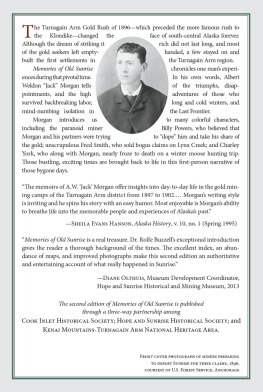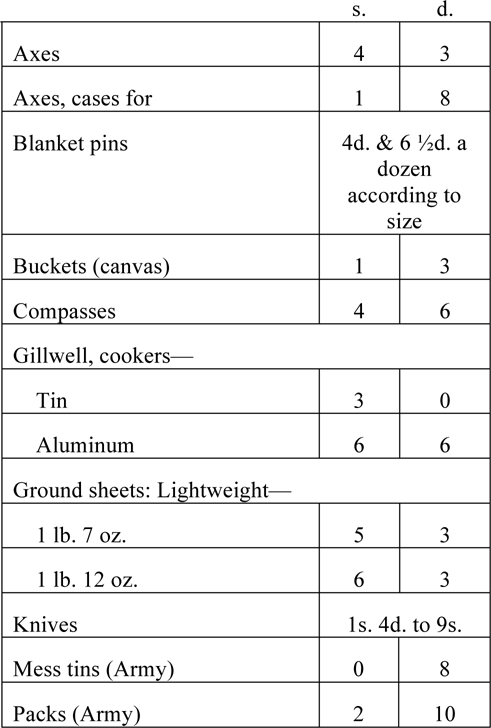THE prices given in this list are those charged by the Equipment Department of Imperial Headquarters (The Scout Shop), but similar articles can be obtained elsewhere.
The Camping Club (Tudor House, 1 Princeton Street, Bedford Row, London. W.C. 1.) supply extremely lightweight camping equipment. Many of their things would be very useful to Scouts and Rovers, but the prices are necessarily high. For instance, their down quilts are ideal for hiking, but cost from to 4, or, if filled with Kapok, between 30s. and
WORKS BY THE
CHIEF SCOUT
SIR ROBERT BADEN-POWELL, Bt.
SCOUTING FOR BOYS. The Official Handbook of the Boy Scouts.
Invaluable advice upon Scouting, together with instruction in good citizenship. Price, cloth, 4/- net (postage 4d.); limp linen, 2/6 net (postage 4d.).
THE SCOUTS FIRST BOOK. This is an abridged edition of the Official Handbook specially prepared for boys. Each member of a troop should obtain a copy for himself. Paper cover, price 4d. net (post free 5d.).
THE ADVENTURES OF A SPY. One of the most interesting books ever written. Exciting experiences thrillingly told. Illustrated (with sketches) by the Author. Price, cloth, 2/6 net (postage 4d.). Paper wrapper, price 2/- net (postage 3d.).
YOUNG KNIGHTS OF THE EMPIRE. Their Code, based on the Ten Scout Laws. And some more Scout Yarns. Second Edition. Cloth, 2/6 net; paper, 1/6 net (postage 4d.).
SCOUTING GAMES. A first-rate collection of Indoor and Outdoor Games specially compiled for Boy Scouts. Seventh Edition. Cloth, 2/6 net; paper, 1/6 net (postage 4d.).
WHAT SCOUTS CAN DO. More Yarns.Illustrated by the Author. In Pictorial paper wrapper, price 2/- net; in cloth boards, price 3/6 net (postage 4d.).
Will be of great interest to both parents and boys. It forms a companion book to Scouting for Boys, with much new matter, written in the Chiefs well-known breezy style. The Field
AN OLD WOLFS FAVOURITES: ANIMALS I HAVE KNOWN. Illustrated by the Author. A Book for Wolf Cubs and Scouts. Paper wrapper, price 1/6 net (postage 3d.). Cloth, 2/6 net (postage 4d.).
LIFES SNAGS AND HOW TO MEET THEM. With Coloured Jacket and numerous Drawings by the Author. Crown 8vo. Cloth. Price 2/6 net (post free 2/10).
This Volume consists of Talks to Young Men written in the Chief Scouts invigorating style.
THE PIPER OF PAX. The Life Story of Sir Robert Baden-Powell, Bt. By E. K. WADE. Crown 8vo. Cloth. With 8 pages of Photographs and other Illustrations. Price 3/6 net (postage 4d.).
There is not a dull page in the book. It is as full of go as B.P.s life has been. There are plenty of delightful anecdotes. Christian Science Monitor
Write for Illustrated List of Books for Boy Scouts to
A. F. SOWTER, Publisher, The Scout Offices, 28 Maiden Lane, London,W.C.2.
Axe
Bathing
Billy
Blankets
Bread
Bread-making
Camera
Camp fire
site
obtaining permission
Candle
Candlesticks
Cape
Clothes hanger
Coat
Comb
Companionship
Cord
Dampers
Distances
Doctor
Electric torches
Equipment
packing of
provision of
weight of
Feet
Fire-lighting
Fireplace
Fire-sticks
Fires
First-Aid Outfit
Food
quantities
storage
Fuel
Ground sheet
Guy-lines
Hat, soft
Jersey
Knife
Lighting, of tent
Mackintosh
Map
Map-case
Matches
Meals
Medicine
Meis
Mirror
Mug
Needle
Notebook
Notification of camp
Packing
Packs
Pillows
Plans
Pocket, fastening
Prayers
Pyjamas
Quantities, food
Railway fares
Ration bags
Razor
Refuse, disposal of
Routes
Rucsacks, how to make
Norwegian or Bergan type
Sanitary arrangements
Second Class work
Shaving
Shoes
Canvas
cleaning materials
Sleeping bags
Soap
Staff
Sweater
Tents
A type
designs for
making
material
pegs
poles
ridge sag
side parrels
size
weight
waterproofing
Turf
Uniform
Wash-basin
Washing
Washing-up
Water
Weight of equipment
Wool
CONTENTS
IV. Equipment(continued)
Tents
HIKING
HIKE is an old English word, which had more or less dropped out of use in this country, but survived in America. However, it has certainly been revived here now by Scouts, and is generally used to describe a journey performed on foot, with tent, bedding, food, and other impedimenta made into some sort of pack and carried on ones back. It also involves the spending of at least one night out-of-doors; a mere days tramp, however much one may carry, cannot strictly be called a hike, though it may be a very valuable way of getting fit and gaining experience for real hikes later on.
The First Class journey should if possible be done as a hike, but this is not definitely laid down in the test because it is not always possible for a Scout to spend a night out. At the same time, it is stated that the journey should preferably be spread over two days, and any Scout who can do so, should certainly pass the test in this way.
Hiking is not an activity for small boys. However skilful and scientific one may be, there is a certain amount that must be carried. It is bound to be a fairly big and heavy bundle, and this, in addition to the distance to be covered, makes hiking suitable only for those who have the necessary size and strength. The small boy does not enjoy himself and is a drag on anyone who goes with him.
Nor is hiking an amusement for the Tenderfoot, however big he may be. It requires a real knowledge of practical Scouting, and the fellow who sets out lacking this, will certainly not enjoy himself and will probably be extremely uncomfortable. The hiker has to put into practice almost the whole of the Second and First Class work. He must know how to read a map and how to find his way if necessary by compass, or even by the sun or the stars; he must be able to pitch a tent, tie knots properly, use an axe, light a fire in any weather and cook his own food: and he must be prepared to meet any emergency and to deal with any accident that may arise. Then, too, the interest of a hike is greatly increased by a knowledge of Nature and the ability to read the meaning of a track, to judge heights and distances, and generally to observe with understanding all that is to be seen by the way, for this will turn what might otherwise be a dull and tiring tramp into a journey full of incident and pleasure.
For those who have the necessary strength and skill it is a glorious experience. It is the real life of the backwoodsman and explorer. The hiker is dependent on himself, and on himself alone, and he learns to be self-reliant, resourceful and patient. He is free to come and go as he will: all ways lie open to him: and adventure may lie waiting round each corner. Time scarcely exists, save when hunger reminds him of the desirability of a meal or the approach of evening warns him that it is time to make his camp for the night. Even the weight on his back gives him a certain satisfaction for he knows that he has with him the means of supplying himself with food, shelter and warmthall that a man really requires, with the exception of companionship, and that is provided by the friend who, similarly equipped, walks by his side.











